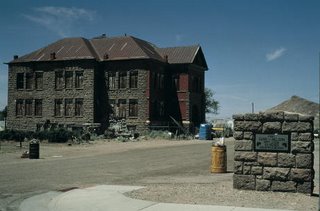
Lunar Crater
Despite its otherworldly name and appearance, Lunar Crater has decidedly earthly roots. More than three-quarters-of-a-mile wide and 430-feet deep, the giant crater was created by geological rather than extraterrestrial causes.
Scientists who have studied the site believe a tremendous volcanic explosion created 400-acre Lunar Crater, which is located about 77 miles northeast of Tonopah via U.S. 6.
Tens of thousands of years ago, groundwater apparently came into contact with magma or hot rocks near the surface. Steam pressure built underground until an enormous eruption left the giant bowl-shaped hole, which geologists call a “maar.”
The crater sits in a virtual nest of more than a dozen extinct volcanic cones and rock-hard lava flows that is known as the Lunar Crater Volcanic Field.
Early Nye County miners and ranchers considered Lunar Crater an interesting novelty. In 1939, Nevada State Park officials erected a sign on the highway guiding visitors to the site. Later, it became an official U.S. Forest Service attraction.
Part of the fascination of Lunar Crater is the fact that it is part of a much greater volcanic field. From its rim, it is possible to look around and see more than a dozen extinct volcanoes (many are not much more than dark mounds of rock).
Additionally, Lunar Crater has a way of surprising. A visitor will cruise along the seven-mile dirt road leading from the highway to the site, craning his or her neck to see something that looks crater-ish and then, at the top of a small rise in the road, it’s suddenly there.
The crater is big. From its upper edge, visitors look down into a huge, bowl-shaped valley that is difficult to visually measure because it is so large.
Sitting on a wooden bench that overlooks Lunar Crater it is hard not to contemplate the tremendous power of Mother Nature—Lunar Crater was essentially formed by a giant burp in the earth’s crust.
The crater is so massive that it seems to generate its own weather, including fierce winds that scream up its steep walls and blast anyone admiring the view.
Lunar Crater does have a slight connection with outer space. In the 1960s, Apollo astronauts trained in the 140,000-acre volcanic field, which does look like a moonscape, in preparation for a lunar landing. More recently, scientists have tested remote sensing and other technologies for use on future Mars explorations.
In addition to Lunar Crater, a secondary dirt road leads to nearby Easy Chair Crater, a collapsed cinder cone that gained its unusual name because, from a distance, it looks like a giant, overstuffed chair.
Across the highway from the road leading to the two craters is the Black Rock Lava Flow, a more recent formation that covers about 1,900 acres. Visitors studying the dark basalt flow will see specks of green, red, and black glass, which formed because the lava cooled so quickly.
The dirt road leading to Lunar Crater is extremely wash-boarded and a high-clearance, four-wheel drive vehicle is recommended.
Lunar Crater is located about 270 miles southeast of Carson City via U.S. 50, U.S. 95 (to Tonopah) and U.S. 6.
For more information about Lunar Crater, contact the Bureau of Land Management, Tonopah Field Station, 1553 South Main St., P.O. Box 911, Tonopah, NV 89049, 775-482-7800, www.nv.blm.gov.






